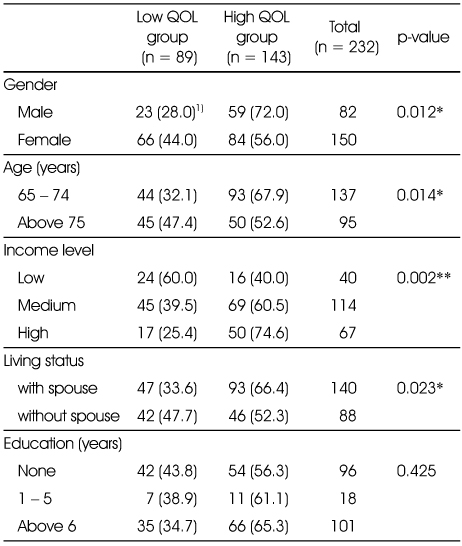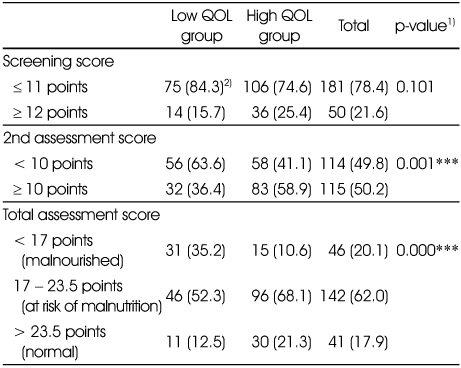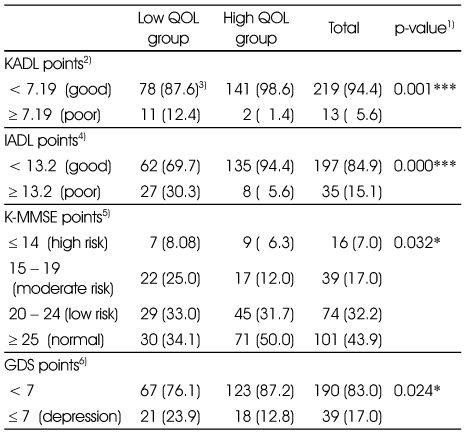References
1. Acree LS, Longfors J, Fjeldstad AS, Fjeldstad C, Schank B, Nickel KJ, Montgomery PS, Gardner AW. Physical activity is related to quality of life in older adults. Health Qual Life Outcomes 2006. 437.
2. Ahn MH, Kim KU. A study of quality of life and depression for the elderly in senior welfare center. J Korea Acad Ind Coop Soc 2012. 13(8)3544–3551.
3. Bize R, Johnson JA, Plotnikoff RC. Physical activity level and health-related quality of life in the general adult population: A systematic review. Prev Med 2007. 45401–415.
4. Brown JE. In : Brown JE, ed. Mini nutritional assessment. Nutrition through the life cycle 2011. 4th edth ed. Wadsworth: 466.
5. Choe JS, Kwon SO, Paik HY. Health-related quality of life by socioeconomic factors and health-related behaviors of the elderly in rural area. Korean J Rural Med 2004. 29(1)29–41.
6. Chung JY, Lee MY, Kim MJ. A study on the prevalence of chronic disease, health-related habits and nutrient intakes according to the quality of life in Korean adults. Korean J Community Nutr 2010. 15(4)445–459.
7. Han MA, Ryu SY, Park J, Kang MG, Park JK, Kim KS. Health-related quality of life assessment by the EuroQol-5D in some rural adults. J Prev Med Public Health 2008. 41(3)173–180.
8. Hagstrom B, Mattsson B, Wimo A, Gunnarsson RK. More illness and less disease? A 20-year perspective on chronic disease and medication. Scand J Public Health 2006. 34584–588.
9. Jang YR, Chiriboga DA, Kim GY. Acculturation and manifestation of depressive symptoms among Korean American older adults. Korean J Res Gerontol 2006. 15(1)51–73.
10. Janssen MF, Birnie E, Haagsma JA, Bonsel GJ. Comparing the standard EQ-5D three-level system with a five-level version. Value Health 2008. 11(2)275–284.
11. Jhoo JH, Kim KW, Lee DY, Youn JC, Lee TJ, Choo IH, Ko HJ, Seo EH, Woo JI. Comparison of the performance in two different Korean versions of Mini-Mental State Examination: MMSE-KC and K-MMSE. J Korean Neuropsychiatr Assoc 2005. 44(1)98–104.
12. Kang E, Shin H, Park H, Jo M, Kim N. A valuation of health status using EQ-5D. Korean J Health Econ Policy 2006. 12(2)19–43.
13. Kim JH, Koo BK, Kim KJ, Baek JW, Lee YK, Lee SK, Lee HS. Characteristics of eating behaviors of the long-lived elderly people in Kyungpook Sung-Ju. Korean J Community Nutr 1999. 4(2)219–230.
14. Kim JY, Lee SG, Lee SK. The relationship between health behaviors, health status, activities of daily living and health-related quality of life in the elderly. J Korean Gerontol Soc 2010. 30(2)471–484.
15. Kim SY, Yun JE, Kimm H, Jee SH. The relation of physical activity by the IPAQ to health-related quality of life - Korea National Health and Nutrition Examination Survey (KHANES) IV 2007-2008. J Korean Soc Health Educ Promot 2011. 28(2)15–25.
16. Kim WK. Subjective and objective social support in the association between physical disability and depression in older adults. Korean J Res Gerontol 2001. 10(1)55–74.
17. Kwon YC, Park JH. Korean Version of Mini-Mental State Examination (MMSE-K) Part I: Development of the Test for the Elderly. J Korean Neuropsychiatr Assoc 1989. 28(1)125–135.
18. Lee MS. Nutritional status of the nonagenarian population in longevity belt in Korea. Korean J Community Nutr 2005. 10(3)290–302.
19. Lee JW, Lee MS, Kim JH, Son SM, Lee BS. Nutritional assessment 2012. Paju: Kyomunsa; 169–238.
21. Lee YH, Choi JS, Rhee JA, Ryu SY, Shin Mh, Kim JH. A study on the application of the Korean valuation weights for EuroQoL-5 dimension. J Korean Soc Health Educ Promot 2009. 26(1)1–13.
22. McNaughton SA, Crawford D, Ball K, Salmon J. Understanding determinants of nutrition, physical activity and quality of life among older adults: the Wellbeing, Eating and Exercise for a Long Life (WELL) study. Health Qual Life Outcomes 2012. 10109.
23. Ministry of Health & Welfare. In-depth analyses of the third Korea National Health and Nutrition Examination Survey (KHANES III) 2005: The health interview and health behavior survey part 2007. cited 2012 Nov. 21. Available from
http://knhanes.cdc.go.kr.
24. Ministry of Health & Welfare. The Korea National Health and Nutrition Examination Survey (KHANES IV) 2007: The health interview and health behavior survey part 2008. cited 2012 Nov. 21. Seoul: Available from
http://knhanes.cdc.go.kr.
26. Park MJ. The cognition, balance, and quality of life in the elderly. J Korean Biol Nurs Sci 2011. 13(2)185–192.
27. Phelan EA, Anderson LA, LaCroix AZ, Larson EB. Older adults' views of "successful aging"- how do they compare with researchers' definitions? J Am Geriatr Soc 2004. 52211–216.
28. Schünemann HJ, Sperati F, Barba M, Santesso N, Melegari C, Akl EA, Guyatt G, Muti P. An instrument to assess quality of life in relation to nutrition: item generation, item reduction and initial validation. Health Qual Life Outcomes 2010. 826.
29. Seong SS, Choi CB, Sung YK, Park YW, Lee HS, Uhm WS, Kim TW, Jun JB, Yoo DH, Lee OY, Bae SC. Health-Related Quality of Life using EQ-5D in Koreans. J Korean Rheum Assoc 2004. 11(3)254–262.
30. So H, Kim H, Ju K. Prediction model of quality of life in elderly based ICF model. J Korean Acad Nurs 2011. 41(4)481–490.
31. Sohn S. A comparison study on the life quality of the elderly and its affecting factors between rural and urban areas. J Korean Gerontol Soc 2006. 26(3)601–615.
32. Sohn S. Factors related to the health related quality of life in elderly women. Korean J Women Health Nurs 2009. 15(2)99–107.
33. Sohn A, Hong IO, Kim J. Health-related quality of life assessment by health behavior and BMI among Seoul citizens. Korean Public Health Res 2010. 36(2)19–25.
34. Spilker B, Revicki DA. In : Spilker B, ed. Taxonomy of quality of life. Quality of life and phamacoeconomics in clinical trials 1996. 2nd edth ed. Philadelphia: Lippincott-Raven Publisher; 25–31.
35. Statistics Korea. Population projections 2010-2060 2012a. cited 2012 Nov. 21. Available from
http://kosis.kr.
36. Statistics Korea. 2010 Life tables for Korea 2012b. cited 2012 Nov. 21. Available from
http://kosis.kr.
37. Statistics Korea. 2010 Census: Population and housing 2012c. cited 2012 Nov. 21. Available from
http://kosis.kr.
38. The EuroQoL group. EuroQoL - a new facility for the measurement of health-related quality of life. Health Policy 1990. 16(3)199–208.
39. Ware JE, Sherbourne CD. The MOS 36-item short-form health survey (SF-36). I. Conceptual framework and item selection. Med Care 1992. 30473–483.
40. WHOQOL Group. The World Health Organization Quality of Life Assessment (WHOQOL): Position paper from the World Health Organization. Soc Sci Med 1995. 41(10)1403–1409.
41. Won CW, Yang KY, Rho YG, Kim SY, Lee EJ, Yoon JL. the development of Korean activities of daily living (K-ADL) and Korean instrumental activities of daily living (K-IADL) scale. J Korean Geriatr Soc 2002. 6(2)107–120.
42. Yun JH, Kang JM, Kim KS, Kim SH, Kim TH, Park YW, Sung YK, Sohn JH, Song BJ, Uhm WS, Yoon HJ, Lee OY, Lee JH, Lee CB, Lee CH, Jung WT, Choe JY, Choi HS, Han DS, Bae SC. Health-Related Quality of Life in Korean Patients with Chronic Diseases. J Korean Rheum Assoc 2004. 11(3)263–274.





